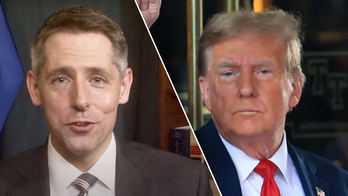Before leaving Seoul, the White House organized a quick trip to Panmunjom, the South Korean side of the Demilitarized Zone, otherwise known as the DMZ.
We journeyed by bus out of the bustling, traffic-snarled capital northward on a highway called Unification Road, the first of many indications of how deeply South Korea seeks to end the nearly 60-year reign of silent tension and alienation with and from the North. The drive took just under 90 minutes.
Photographs are limited due to severe security restrictions. We stopped on the edge of the Joint Security Area and met two exceptional members of the US military contingent: Infatry Maj. Michael T. Eggers, U.S. Army Joint Duty Officer, and Sgt. Robert Juarez, Security Escort.
Our bus stopped near Freedom House, the South Korean structure built to facilitate the reunification of North Koreans and South Koreans. Sgt. Juarez told us this was built as a sign of hope on the South Korean side, a place where family reunification could occur in privacy and with maximum security and safety. He sadly observed the modern, multi-level building, gleaming with a two-story glass covered foyer and polished marble inside, has never hosted a family reunification. No photographs of Freedom House were permitted.
From the steps on the north side of Freedom House we could see Conference Row, a set of low-slung blue rectangular buildings. On this row squat the Military Armistice Commission (MAC) Buildings. These buildings are where tense, highly formal negotiations take place between North Korean representatives and those with the United Nations Command Security Force - Joint Security Area (UNCSF-JSA).
Just north of the MAC buildings, on a slight slope, stood the imposing North Korean fortress known as Panmun-Gak. While standing on the steps, I momentarily raised my right hand to motion toward Panmun-Gak. Swiftly and curtly, Sgt. Juarez reminded to make no hand gestures at all while in sight of any North Korean soldier or structure. Juarez had warned us upon our arrival that North Korean soldiers look for any sign of provocation, no matter how small or benign. We were told not to point, wave and make any visible hand gesture of any kind. I had forgotten, but Juarez's stern reminder crystallized the unrelenting sense of tension that exists every hour along the DMZ.
I noticed a North Korean officer came out of the Panmun-Gak. I raised my camera and shot one picture. He raised his in return. We took pictures of one another.
If it's possible to feel military tension, maintained and reinforced for more than 55 years, it felt a flash of it through my viewfinder.
We went inside one of the Conference Buildings. Inside were two ROK (Republic of Korea) soldiers. They stood silent post at a stance and near-maximum physical tension: legs shoulder-length apart, gloved hands tightened into a fist, faces resolutely forward - expressionless throughout. We posed for pictures as a sign of respect. This is approved and not viewed by the US or South Korean personnel as a lark.
Trust me, there is nothing light or informal about this experience at all. Through a thick glass window I spotted two other ROK soldiers who guard the space between the Conference Row buildings, to deter encroachment from North Korean forces.
I posed also with Maj. Egger. He's a no-nonsense officer with a dash of humor - he laughed when I introduced myself as a "fake Major, 47 years and no promotions." He worried, needlessly, that he might break the lens of my new Nikon.
This was a rare light-hearted moment. Juarez said the conference building was divided in half, South Korean territory south of the wood conference table adorned with a United Nation flags, North Korean territory north of the table. Many of us "crossed over" into North Korea, finding it a bit thrilling. Juarez and Egger never crossed over. They said it's not a thrill to them, but military buisness to mind, secure and respect the line. Pretending to cross, they said, carried no thrill or sense of adventure. It only represented a chance for misunderstanding, more tension and hostility - none of which they wanted any part of. Their demeanor reminded this somewhat jocular band of reporters that we were on more than a field trip -- we were witnesses to a trip wire, a place where countless military personnel have sacrificed for years to maintain peace, an armistice, in the ever-present hope (however dim) that one day a treaty will officially end the Korean War and reunify the peninsula.
We also saw the flag pole on which the 90-yard-long flag of North Korea flies over a nearly empty propaganda village near the DMZ, a mini-city of Hollywood-style fakery meant to convey an advanced, modern-day urbanity.
Nothing like this exists in North Korea, hence the need for a propaganda village. All that was real there was the flag pole, the massive flag and a stiff breeze that starched it against the sky.
We were also driven to the Bridge of No Return, the bridge over which all repatriated prisoners of war crossed when the armistice was signed. The returning UN soldiers would be stopped on the bridge, his identity verified before the crossing was complete.
The crew of the U.S.S. Pueblo returned to South Korea over this bridge. http://www.foxnews.com/story/0,2933,489344,00.html
Though discarded as a formal crossing point now, the Bridge of No Return remains the only ground link between North and South. I shot pictures of the Bridge and a dingy sign to the left that reads "Military Demarcation Line" in English and Korean.
Near the Bridge of No Return is a concrete memorial to Capt. Arthur Bonifas and Lt. 1st Class Mark Barrett, slain in the infamous Axe Murders of 1976: http://www.vfwpost7591.org/opn-PB.html
The memorial stands near the spotof Bonifas' murder at the hands of axe-wielding North Koreans. The memorial is where a large Poplar tree that needed regular trimming for visibility near the Bridge of No Return and CP#3 (Checkpoint Number 3, a blue building of which I also took pictures). The story of the axe murders is indescribably brutal and heart-rending. Barrett was attacked too, but hobbled away but did not receive medical treatment in time to survive. We had only moments to take in the barbarity of what happened here but the sense of dread was nevertheless palpable. The setting sun and coming hint of twilight only deepened the sense of remorseless savagery -- and the amazing sense of calm and restraint the UN forces exercised to avoid a full-blown restart of the war.
Soon, we were on our way south to Seoul. But North Korea was still visible in the distance, its mountains crouching beneath the setting sun, its fallow rice paddies a grayish smear in valley below. As I snapped my camera to capture the sun, the low-slung hills and even a tree with a bird's nest peeking through the denuded branches, it occurred to me the sun has been setting perpetually on the North since the end of the war - never yet to rise.




